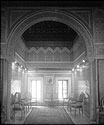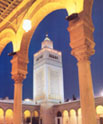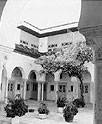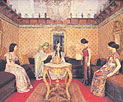|
Refuge of rural population
Place of reception of a population with low-income, the medina became also a hypertrophied popular economic center. Workshops and trade infiltrate in the core of dwelling, accentuating the deterioration of the quality of the life. Zones like Hafsia, formerly prosperous district of the Jews, were issued by the colonial powers zones unhealthy and dedicated to the demolition.
Projects of openings transfer during the day in the medina was so much apprehended like an obstacle to circulation, even with the development and progress. It had to be integrated in its “environment”, heard the flourishing colonial city and proudly triumphing. The old order was thus to be subjected to the new order. Thus were designed new buildings HLM on four floors of Hafsia, raised in an orthogonal and vehicular screen.
A survival of a precious seat of civilization

Nowadays, the notion of integration has widely changed. It recommend the respect of the principle of modernization of equipments, or the systemic renovation of the housings when it appears necessary; but a renovation that Nowadays, the concept of integration changed widely. it recommends the respect of the old order without rejecting the principle of the modernization of the equipment, or the systematic restoration of the habitat when that’s really necessary; but a restoration which makes lose with the unit neither its homogeneity neither its harmony, neither its typical architectural seal, nor its prevalent functions.
To promote tourism for example, by a methodical and intelligent exploitation of the monuments reallocated at cultural ends or leisure’s is a solution which can, if it is well carried out, reconcile the requirements of the protection of the inheritance with the requirements of the development. Six hundred historic buildings, of which several traversed centuries to reach us, lend themselves admirably, each one in its kind and according to its suitability, with the necessary change-adaptation to the contemporary life.The mosques will continue their religious mission naturally, as place of prayer in a company which remains very respectful of its beliefs.
 It can also for those which the history and art attract, be the subject of visits which will give the opportunity to them to admire these masterpieces of the Muslim art. Zitouna, one of the most prestigious monuments of North Africa, founded by Hassane Ibn Noômane (704 JC. approximately), which was built for the first time by the governor Abadallah Ibn Al-Habhab in 732 j.C and second once in 864 j.C on order of the caliph of Baghdad, its architecture of the 9th century preserves still completely. It was until the 19th century the large Maghrebian university, as well as Qarawiyine of Fès or Al Azhar of Cairo. It can also for those which the history and art attract, be the subject of visits which will give the opportunity to them to admire these masterpieces of the Muslim art. Zitouna, one of the most prestigious monuments of North Africa, founded by Hassane Ibn Noômane (704 JC. approximately), which was built for the first time by the governor Abadallah Ibn Al-Habhab in 732 j.C and second once in 864 j.C on order of the caliph of Baghdad, its architecture of the 9th century preserves still completely. It was until the 19th century the large Maghrebian university, as well as Qarawiyine of Fès or Al Azhar of Cairo.
Always in the same quadrilateral of the central souks, one can also see the first médersa of North Africa, Chammaiya (13th century) transform in school of training of the craft industry, Mouradiya (17th century) located in the souk of the women; and not far in the souk El Quachachine, the médersa In-Nakhla where the religious book of the coran is taught, the médersa Slimaniya sits of medical associations, the médersa Bachya reallocated like professional training center and, finally, Bachiya's association of the former students of the college is sitted in the street of the Pasha.
As for the médersa "Achouria" located in the street Hawanet Achour close to Dar Lasram, head office of the ASM and the cultural club Tahar Haddad (using the makhzen of Dar Lasram), it is transformed into house of the Religious Organizations. In the same district we find the whole modern part of Hafsia, which was the object of an operation of urban renovation being worth to the ASM (Association of Safeguard of the Medina) in 1983 and 1995, the price Aga Khan of architecture.
In the southern part of the medina, the visit of the Museum of Arts and popular Traditions (Dar Ben Abdallah) could be supplemented by that of Dar Othman where the museum of the craft industry and also of Tourbet el-bey will be arranged where were buried starting from 1775 J.C the members of the dynasty husseinite and certain dignitaries very close to the beylicale family.
 On the side of Bab Souika, the installation of the place enables us today to admire the beautiful modern architectural unit which tends to emphasize the imposing masses of the cupolas of Sidi Mehrez (17th century) and the complex of Halfaouine, work of the important visir “minister” Youssef Saheb At-Tabâa (19th century) entirely restored. On the side of Bab Souika, the installation of the place enables us today to admire the beautiful modern architectural unit which tends to emphasize the imposing masses of the cupolas of Sidi Mehrez (17th century) and the complex of Halfaouine, work of the important visir “minister” Youssef Saheb At-Tabâa (19th century) entirely restored.
 Further, closing the Northern suburb, one can still admire what remains of ramparts remade at the beginning of the 19th century: Bab El Khadhra, Bab Laasal, Borj and further, Bab saâdoun refitted approximately a century ago. These many operations , of great scale were worth at the town of Tunis in 1985 the price of the organization of the Arab cities for the safeguard of the architectural heritage. Further, closing the Northern suburb, one can still admire what remains of ramparts remade at the beginning of the 19th century: Bab El Khadhra, Bab Laasal, Borj and further, Bab saâdoun refitted approximately a century ago. These many operations , of great scale were worth at the town of Tunis in 1985 the price of the organization of the Arab cities for the safeguard of the architectural heritage.
By aiming at the safeguard of the inheritance, it attacks in fact a fragile and invaluable world where the man, nature, the spiritual message and the material elements of the culture are closely dependant. To save these impregnated alive cities of culture, in charge of history, to integrate them in a world mechanized and modern in full technological mutation are not an easy task. But the challenge was launched as well to Tunis as in Fès and than in Algeria….
By Dr. Abd El Aziz Daouletly |